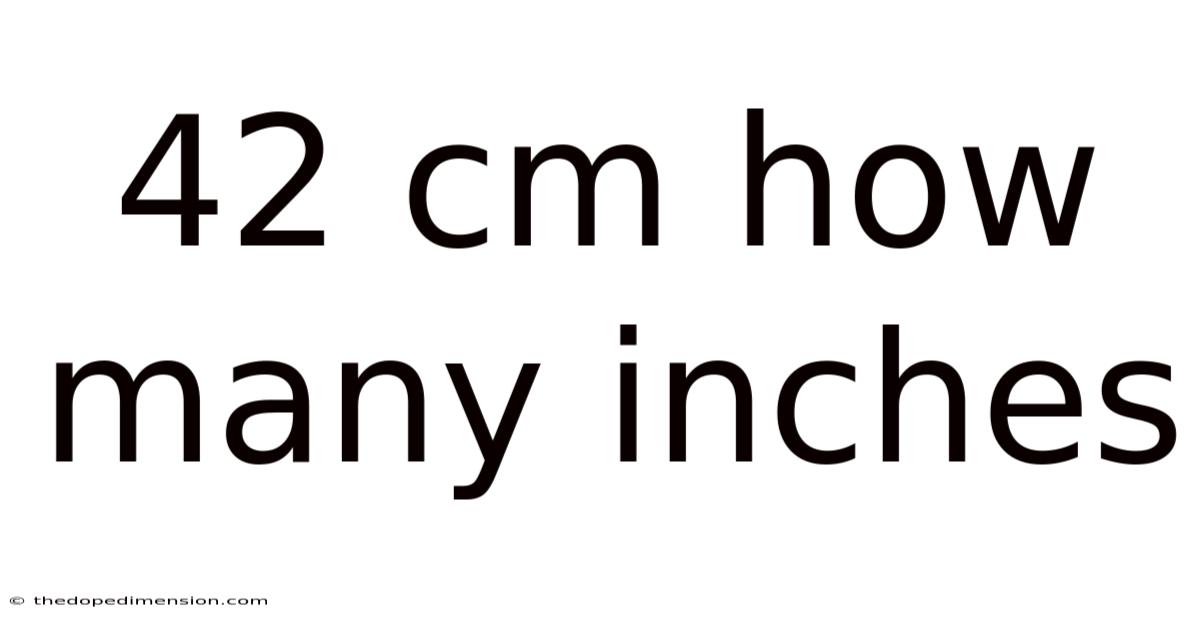42 Cm How Many Inches
thedopedimension
Sep 08, 2025 · 4 min read

Table of Contents
42 cm: How Many Inches? A Comprehensive Guide to Metric-Imperial Conversions
Are you struggling with converting centimeters to inches? Feeling lost in the world of metric and imperial measurements? You're not alone! Many people find themselves needing to convert between these systems, especially when working with dimensions, crafting projects, or understanding international specifications. This comprehensive guide will delve deep into converting 42 centimeters to inches, explaining the process, providing the answer, and exploring the broader context of metric-imperial conversions. We'll also cover common applications and address frequently asked questions. By the end, you'll not only know how many inches are in 42 cm but also possess a solid understanding of the conversion process itself.
Understanding the Conversion Factor
The fundamental principle behind converting between centimeters (cm) and inches (in) lies in their defined relationship. One inch is exactly equal to 2.54 centimeters. This conversion factor is the key to unlocking any centimeter-to-inch conversion. Understanding this simple equation allows you to effortlessly translate measurements between the two systems. We can express this as:
1 inch = 2.54 centimeters
Or, conversely:
1 centimeter = 0.3937 inches (approximately)
Calculating 42 cm to Inches
Now, let's tackle the specific question: How many inches are in 42 centimeters? To find the answer, we'll use the conversion factor:
-
Set up the equation: We know that 1 inch = 2.54 cm. We want to find the equivalent of 42 cm in inches. Therefore, our equation is:
x inches = 42 cm
-
Apply the conversion factor: We need to divide the centimeters by the conversion factor (2.54 cm/inch):
x inches = 42 cm / 2.54 cm/inch
-
Calculate the result: Performing the calculation gives us:
x inches ≈ 16.535 inches
Therefore, 42 centimeters is approximately equal to 16.535 inches.
Rounding and Precision
In practical applications, you'll often need to round your answer to a specific level of precision. For instance:
- Rounding to one decimal place: 16.5 inches
- Rounding to the nearest whole number: 17 inches
The appropriate level of rounding depends on the context. For precise engineering work, you'll likely need more decimal places, while for less demanding tasks, rounding to the nearest inch might suffice.
Practical Applications of Centimeter-to-Inch Conversions
The need for converting between centimeters and inches arises in numerous situations:
-
International Trade: Many products are manufactured with dimensions specified in centimeters, but sold in countries that primarily use inches. This conversion is crucial for accurate labeling and compatibility.
-
Construction and Engineering: Blueprints and architectural drawings may use both metric and imperial units. Accurate conversion is essential to avoid errors in construction and design.
-
DIY and Crafting: Whether you're following a pattern for knitting, sewing, or woodworking, you might encounter measurements in either centimeters or inches. Conversion ensures accuracy in your project.
-
Clothing and Apparel: Some clothing size charts might list measurements in centimeters, while others use inches. Converting allows you to find the right size.
-
Medical and Healthcare: Medical devices and instruments may have dimensions specified in both systems. Accurate conversion is crucial for proper functioning and patient safety.
-
Automotive Industry: The automotive industry often uses both metric and imperial systems, necessitating precise conversions for parts manufacturing and assembly.
Beyond 42 cm: Mastering Centimeter-to-Inch Conversions
The method demonstrated above for converting 42 centimeters to inches applies to any centimeter measurement. Simply replace 42 with the desired centimeter value and follow the same calculation steps:
- Convert x centimeters to inches: x cm / 2.54 cm/inch = y inches
This formula is your key to effortlessly converting any centimeter measurement into its inch equivalent.
Frequently Asked Questions (FAQ)
Q: Why are there two different measurement systems?
A: The metric system (based on centimeters, meters, etc.) is a decimal system, making calculations simpler and more consistent. The imperial system (based on inches, feet, etc.) developed historically and is still prevalent in some countries.
Q: Is it always necessary to use the exact conversion factor (2.54)?
A: Using the exact conversion factor ensures the greatest accuracy. However, for less precise applications, an approximate conversion factor (like 0.4 for cm to inches or 2.5 for inches to cm) might suffice.
Q: What are some common online converters for cm to inches?
A: Many websites offer free online converters for cm to inches. These tools can save time and effort, but understanding the underlying conversion principle remains valuable.
Q: Are there any tools to help me with these conversions besides online calculators?
A: Many smartphones and calculators have built-in unit conversion features that can handle cm to inch conversions easily.
Conclusion
Converting 42 centimeters to inches is a straightforward process using the fundamental conversion factor of 2.54 centimeters per inch. Understanding this core principle empowers you to handle any centimeter-to-inch conversion confidently. This knowledge is valuable across diverse fields, from everyday tasks to professional applications. Remember that the choice of rounding precision depends on the context of the measurement, but the underlying principle remains consistent. Now you're equipped to tackle any metric-imperial measurement challenge with ease and accuracy. So, go forth and conquer those conversions!
Latest Posts
Latest Posts
-
50 000 Kb To Mb
Sep 09, 2025
-
4 Liters How Many Milliliters
Sep 09, 2025
-
Three Quarters Of A Pound
Sep 09, 2025
-
Convert Centimeter To Square Feet
Sep 09, 2025
-
Yards To Tons Conversion Calculator
Sep 09, 2025
Related Post
Thank you for visiting our website which covers about 42 Cm How Many Inches . We hope the information provided has been useful to you. Feel free to contact us if you have any questions or need further assistance. See you next time and don't miss to bookmark.